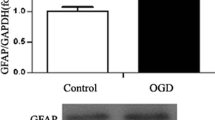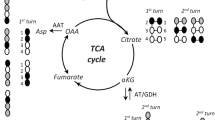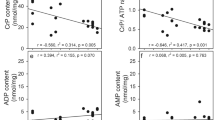Abstract
2-Deoxy-d-[14C]glucose ([14C]DG) is commonly used to determine local glucose utilization rates (CMRglc) in living brain and to estimate CMRglc in cultured brain cells as rates of [14C]DG phosphorylation. Phosphorylation rates of [14C]DG and its metabolizable fluorescent analog, 2-(N-(7-nitrobenz-2-oxa-1,3-diazol-4-yl)amino)-2-deoxyglucose (2-NBDG), however, do not take into account differences in the kinetics of transport and metabolism of [14C]DG or 2-NBDG and glucose in neuronal and astrocytic cells in cultures or in single cells in brain tissue, and conclusions drawn from these data may, therefore, not be correct. As a first step toward the goal of quantitative determination of CMRglc in astrocytes and neurons in cultures, the steady-state intracellular-to-extracellular concentration ratios (distribution spaces) for glucose and [14C]DG were determined in cultured striatal neurons and astrocytes as functions of extracellular glucose concentration. Unexpectedly, the glucose distribution spaces rose during extreme hypoglycemia, exceeding 1.0 in astrocytes, whereas the [14C]DG distribution space fell at the lowest glucose levels. Calculated CMRglc was greatly overestimated in hypoglycemic and normoglycemic cells because the intracellular glucose concentrations were too high. Determination of the distribution space for [14C]glucose revealed compartmentation of intracellular glucose in astrocytes, and probably, also in neurons. A smaller metabolic pool is readily accessible to hexokinase and communicates with extracellular glucose, whereas the larger pool is sequestered from hexokinase activity. A new experimental approach using double-labeled assays with DG and glucose is suggested to avoid the limitations imposed by glucose compartmentation on metabolic assays.



Similar content being viewed by others
Abbreviations
- CMRglc :
-
Cerebral rate of glucose utilization
- DG:
-
2-Deoxy-d-glucose
- DMEM:
-
Dulbecco’s modified Eagle medium
- Glc:
-
Glucose
- IAP:
-
4-Iodo-[N-methyl]antipyrine or iodoantipyrine
- Methylglucose:
-
3-O-methyl-d-glucose
- 2- or 6-NBDG:
-
2- or 6-(N-(7-nitrobenz-2-oxa-1,3-diazol-4-yl)amino)-2-deoxyglucose
- PBS:
-
Phosphate-buffered saline
References
Sokoloff L, Reivich M, Kennedy C, Des Rosiers MH, Patlak CS, Pettigrew KD, Sakurada O, Shinohara M (1977) The [14C]deoxyglucose method for the measurement of local cerebral glucose utilization: theory, procedure, and normal values in the conscious and anesthetized albino rat. J Neurochem 28:897–916
Holden JE, Mori K, Dienel GA, Cruz NF, Nelson T, Sokoloff L (1991) Modeling the dependence of hexose distribution volumes in brain on plasma glucose concentration: implications for estimation of the local 2-deoxyglucose lumped constant. J Cereb Blood Flow Metab 11:171–182
Dienel GA, Cruz NF, Mori K, Holden JE, Sokoloff L (1991) Direct measurement of the lambda of the lumped constant of the deoxyglucose method in rat brain: determination of lambda and lumped constant from tissue glucose concentration or equilibrium brain/plasma distribution ratio for methylglucose. J Cereb Blood Flow Metab 11:25–34
Dienel GA, Cruz NF, Adachi K, Sokoloff L, Holden JE (1997) Determination of local brain glucose level with [14C]methylglucose: effects of glucose supply and demand. Am J Physiol 273:E839–E849
Simpson IA, Carruthers A, Vannucci SJ (2007) Supply and demand in cerebral energy metabolism: the role of nutrient transporters. J Cereb Blood Flow Metab 27:1766–1791
Simpson IA, Dwyer D, Malide D, Moley KH, Travis A, Vannucci SJ (2008) The facilitative glucose transporter GLUT3: 20 years of distinction. Am J Physiol Endocrinol Metab 295:E242–E253
Cummins CJ, Glover RA, Sellinger OZ (1979) Neuronal cues regulate uptake in cultured astrocytes. Brain Res 170:190–193
Hara M, Matsuda Y, Hirai K, Okumura N, Nakagawa H (1989) Characteristics of glucose transport in neuronal cells and astrocytes from rat brain in primary culture. J Neurochem 52:902–908
Takahashi S, Driscoll BF, Law MJ, Sokoloff L (1995) Role of sodium and potassium ions in regulation of glucose metabolism in cultured astroglia. Proc Natl Acad Sci USA 92:4616–4620
Kaufman EE, Driscoll BF (1992) Carbon dioxide fixation in neuronal and astroglial cells in culture. J Neurochem 58:258–262
Sakurada O, Kennedy C, Jehle J, Brown JD, Carbin GL, Sokoloff L (1978) Measurement of local cerebral blood flow with iodo [14C] antipyrine. Am J Physiol 234:H59–H66
Passonneau JV, Lowry OH (1993) Enzymatic analysis. A practical guide. Humana Press, Totowa
Dienel GA, Cruz NF, Mori K, Sokoloff L (1990) Acid lability of metabolites of 2-deoxyglucose in rat brain: implications for estimates of kinetic parameters of deoxyglucose phosphorylation and transport between blood and brain. J Neurochem 54:1440–1448
Dienel GA, Cruz NF (1993) Synthesis of deoxyglucose-1-phosphate, deoxyglucose-1,6-bisphosphate, and other metabolites of 2-deoxy-d-[14C]glucose in rat brain in vivo: influence of time and tissue glucose level. J Neurochem 60:2217–2231
Dienel GA, Cruz NF, Sokoloff L (1993) Metabolites of 2-deoxy-[14C]glucose in plasma and brain: influence on rate of glucose utilization determined with deoxyglucose method in rat brain. J Cereb Blood Flow Metab 13:315–327
Grossbard L, Schimke RT (1966) Multiple hexokinases of rat tissues. Purification and comparison of soluble forms. J Biol Chem 241:3546–3560
DiNuzzo M, Mangia S, Maraviglia B, Giove F (2010) Glycogenolysis in astrocytes supports blood-borne glucose channeling not glycogen-derived lactate shuttling to neurons: evidence from mathematical modeling. J Cereb Blood Flow Metab 30:1895–1904
Walls AB, Heimburger CM, Bouman SD, Schousboe A, Waagepetersen HS (2009) Robust glycogen shunt activity in astrocytes: effects of glutamatergic and adrenergic agents. Neuroscience 158:284–292
Passonneau JV, Crites SK (1976) Regulation of glycogen metabolism in astrocytoma and neuroblastoma cells in culture. J Biol Chem 251:2015–2022
Passonneau JV, Lowry OH, Schulz DW, Brown JG (1969) Glucose 1,6-diphosphate formation by phosphoglucomutase in mammalian tissues. J Biol Chem 244:902–909
Lowry OH, Passonneau JV (1964) The relationships between substrates and enzymes of glycolysis in brain. J Biol Chem 239:31–42
Colowick SP, Sutherland EW (1942) Polysaccharide synthesis from glucose by means of purified enzymes. J Biol Chem 144:423–437
Mori K, Cruz N, Dienel G, Nelson T, Sokoloff L (1989) Direct chemical measurement of the lambda of the lumped constant of the [14C]deoxyglucose method in rat brain: effects of arterial plasma glucose level on the distribution spaces of [14C]deoxyglucose and glucose and on lambda. J Cereb Blood Flow Metab 9:304–314
Tomioka S (2012) Water transport by glucose transporter type 3 expressed in Xenopus oocytes. NeuroReport 23:21–25
MacAulay N, Zeuthen T (2010) Water transport between CNS compartments: contributions of aquaporins and cotransporters. Neuroscience 168:941–956
Nakanishi H, Cruz NF, Adachi K, Sokoloff L, Dienel GA (1996) Influence of glucose supply and demand on determination of brain glucose content with labeled methylglucose. J Cereb Blood Flow Metab 16:439–449
Walz W, Mukerji S (1988) Lactate release from cultured astrocytes and neurons: a comparison. Glia 1:366–370
Walz W, Mukerji S (1990) Simulation of aspects of ischemia in cell culture: changes in lactate compartmentation. Glia 3:522–528
Walz W, Hertz L (1983) Intracellular ion changes of astrocytes in response to extracellular potassium. J Neurosci Res 10:411–423
Chen Y, McNeill JR, Hajek I, Hertz L (1992) Effect of vasopressin on brain swelling at the cellular level: do astrocytes exhibit a furosemide–vasopressin-sensitive mechanism for volume regulation? Can J Physiol Pharmacol 70(Suppl):S367–S373
Latzkovits L, Cserr HF, Park JT, Patlak CS, Pettigrew KD, Rimanoczy A (1993) Effects of arginine vasopressin and atriopeptin on glial cell volume measured as 3-MG space
Speizer L, Haugland R, Kutchai H (1985) Asymmetric transport of a fluorescent glucose analogue by human erythrocytes. Biochim Biophys Acta 815:75–84
Cloherty EK, Sultzman LA, Zottola RJ, Carruthers A (1995) Net sugar transport is a multistep process. Evidence for cytosolic sugar binding sites in erythrocytes. Biochemistry 34:15395–15406
Chuquet J, Quilichini P, Nimchinsky EA, Buzsaki G (2010) Predominant enhancement of glucose uptake in astrocytes versus neurons during activation of the somatosensory cortex. J Neurosci 30:15298–15303
Dinuzzo M, Giove F, Maraviglia B, Mangia S (2013) Glucose metabolism down-regulates the uptake of 6-(N-(7-nitrobenz-2-oxa-1,3-diazol-4-yl)amino)-2-deoxyglucose (6-NBDG) mediated by glucose transporter 1 isoform (GLUT1): theory and simulations using the symmetric four-state carrier model. J Neurochem 125:236–246
Siesjö BK (1978) Brain energy metabolism. John Wiley & Sons, Chichester
Ghajar JB, Plum F, Duffy TE (1982) Cerebral oxidative metabolism and blood flow during acute hypoglycemia and recovery in unanesthetized rats. J Neurochem 38:397–409
Balmer D, Emery M, Andreux P, Auwerx J, Ginet V, Puyal J, Schorderet DF, Roduit R (2013) Autophagy defect is associated with low glucose-induced apoptosis in 661 W photoreceptor cells. PLoS ONE 8:e74162
Mohseni S (2011) Autophagy in insulin-induced hypoglycaemic neuropathy. Pathology 43:254–260
Yue Z, Friedman L, Komatsu M, Tanaka K (2009) The cellular pathways of neuronal autophagy and their implication in neurodegenerative diseases. Biochim Biophys Acta 1793:1496–1507
Deegan S, Saveljeva S, Gorman AM, Samali A (2013) Stress-induced self-cannibalism: on the regulation of autophagy by endoplasmic reticulum stress. Cell Mol Life Sci 70:2425–2441
Mir SUR, George NM, Zahoor L, Harms R, Guinn Z, Sarvetnick NE (2015) Inhibition of autophagic turnover in β-cells by fatty acids and glucose leads to apoptotic cell death. J Biol Chem 290:6071–6085
Young JE, Martinez RA, La Spada AR (2009) Nutrient deprivation induces neuronal autophagy and implicates reduced insulin signaling in neuroprotective autophagy activation. J Biol Chem 284:2363–2373
Xi H, Kurtoglu M, Liu H, Wangpaichitr M, You M, Liu X, Savaraj N, Lampidis TJ (2011) 2-Deoxy-d-glucose activates autophagy via endoplasmic reticulum stress rather than ATP depletion. Cancer Chemother Pharmacol 67:899–910
Kamiya Y, Satoh T, Kato K (2012) Molecular and structural basis for N-glycan-dependent determination of glycoprotein fates in cells. Biochim Biophys Acta 1820:1327–1337
Herscovics A (1999) Importance of glycosidases in mammalian glycoprotein biosynthesis. Biochim Biophys Acta 1473:96–107
Kim I, Xu W, Reed JC (2008) Cell death and endoplasmic reticulum stress: disease relevance and therapeutic opportunities. Nat Rev Drug Discov 7:1013–1030
Jonas AJ, Conrad P, Jobe H (1990) Neutral-sugar transport by rat liver lysosomes. Biochem J 272:323–326
Mancini GM, Beerens CE, Verheijen FW (1990) Glucose transport in lysosomal membrane vesicles. Kinetic demonstration of a carrier for neutral hexoses. J Biol Chem 265:12380–12387
Schmidt S, Joost HG, Schurmann A (2009) GLUT8, the enigmatic intracellular hexose transporter. Am J Physiol Endocrinol Metab 296:E614–E618
Reagan LP, Rosell DR, Alves SE, Hoskin EK, McCall AL, Charron MJ, McEwen BS (2002) GLUT8 glucose transporter is localized to excitatory and inhibitory neurons in the rat hippocampus. Brain Res 932:129–134
Piroli GG, Grillo CA, Hoskin EK, Znamensky V, Katz EB, Milner TA, McEwen BS, Charron MJ, Reagan LP (2002) Peripheral glucose administration stimulates the translocation of GLUT8 glucose transporter to the endoplasmic reticulum in the rat hippocampus. J Comp Neurol 452:103–114
Gandhi GK, Ball KK, Cruz NF, Dienel GA (2010) Hyperglycaemia and diabetes impair gap junctional communication among astrocytes. ASN Neuro 2:e00030
Lind KR, Ball KK, Cruz NF, Dienel GA (2013) The unfolded protein response to endoplasmic reticulum stress in cultured astrocytes and rat brain during experimental diabetes. Neurochem Int 62:784–795
Piroli GG, Grillo CA, Charron MJ, McEwen BS, Reagan LP (2004) Biphasic effects of stress upon GLUT8 glucose transporter expression and trafficking in the diabetic rat hippocampus. Brain Res 1006:28–35
Hertz L, Peng L, Lai JC (1998) Functional studies in cultured astrocytes. Methods 16:293–310
Song D, Xu J, Hertz L, Peng L (2015) Regulatory volume increase in astrocytes exposed to hypertonic medium requires beta1 -adrenergic Na(+)/K(+) -ATPase stimulation and glycogenolysis. J Neurosci Res 93:130–139
Lange S, Bak L, Waagepetersen H, Schousboe A, Norenberg M (2012) Primary Cultures of Astrocytes: their Value in Understanding Astrocytes in Health and Disease. Neurochem Res 37:2569–2588
Author information
Authors and Affiliations
Corresponding author
Ethics declarations
Conflict of interest
The authors declare that they have no conflict of interest.
Additional information
Special Issue: In honor of Dr. Mary McKenna.
Rights and permissions
About this article
Cite this article
Dienel, G.A., Cruz, N.F., Sokoloff, L. et al. Determination of Glucose Utilization Rates in Cultured Astrocytes and Neurons with [14C]deoxyglucose: Progress, Pitfalls, and Discovery of Intracellular Glucose Compartmentation. Neurochem Res 42, 50–63 (2017). https://doi.org/10.1007/s11064-015-1650-x
Received:
Revised:
Accepted:
Published:
Issue Date:
DOI: https://doi.org/10.1007/s11064-015-1650-x




